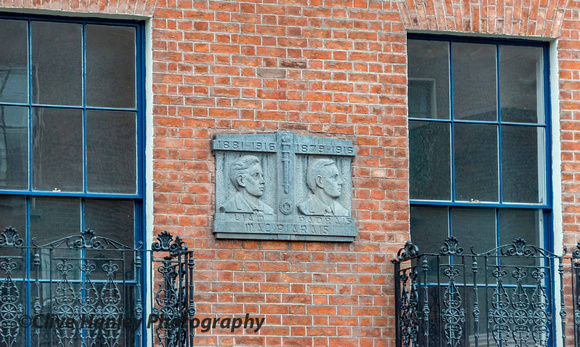Two of the Leaders of the Easter Rising 1916. Patrick Pearse held the position of President of the Provisional Government of the Irish Republic declared on 24th April 1916 and was the author of much
An acclaimed speaker he had come to national prominence in August 1915 when he delivered the fiery graveside oration during the O’Donovan Rossa funeral that became the “call to arms” for the 1916 Rising with its famous last line “Ireland unfree shall never be at peace”.
He was born on Gt Brunswick St (now Pearse St) in Dublin. His English father was James Pearse a monumental sculptor and Pádraig’s mother was Meath born Margaret Brady. Patrick was named after the American founding father Patrick Henry himself a revolutionary orator remembered for his “Give me Liberty, or give me Death” speech.
Patrick through his aunt Margaret was drawn towards the myths and ancient history of Ireland and joined the Gaelic League in 1895 and was editor of their newspaper “An Claidheamh Soluis” (The Sword of Light) from 1903 for six years. His Irish language activism brought him into political life and he attended the founding meeting of Sinn Féin in the Rotunda in 1905.
In 1908 he used his savings to open an Irish School St Endas. It was a pioneering school, using progressive educational methods and bilingualism which Pádraig had studied in Belgium. Patrick attended the founding of the Irish Volunteers in Wynns Hotel in 1913 and he spoke at the mass meetings of the Volunteers organised by the Irish Republican Brotherhood (IRB) in the Rotunda on 25th November 1913.
After the outbreak of World War One John Redmond split from the Irish Volunteers and set up the National Volunteers to fight in the British Army to secure Home Rule. The strong IRB element within the now smaller Irish Volunteers continued to plan for an Irish Republic.
Pearse joined the secret Military Council of The Irish Republican Brotherhood in May 1915 who were in planning for the subsequent Rising. His brother Willie Pearse had joined him on the teaching staff at St Endas along with Thomas McDonagh and Con Colbert and these four masters were all executed after the Rising.
After the confusion surrounding the countermanding orders issued by Irish Volunteers president Eoin MacNeill and the failed attempt to land German arms and arrest of Roger Casement the Rising originally proposed for Easter Sunday was postponed until Easter Monday 24th April 1916.
At 12 noon at the General Post Office (GPO) on O’Connell Street Dublin, one of many buildings taken over by the members of the Army of the Irish Republic, Pádraig read aloud the Proclamation of the Irish Republic which he had written. The GPO was held till fires caused from the continual bombardment forced an evacuation to Moore St.
After witnessing unarmed civilians with a white flag being shot down by the British, Pearse decided to surrender. In a note to the British Brigadier General Lowe he wrote “to prevent the further slaughter of the civilian population and in the hope of saving our followers, now hopelessly surrounded and outnumbered”. Pearse surrendered on Gt Britain St (now Parnell St) to Lowe in the presence of Nurse Elizabeth O’Farrell who carried the original note.
Pearse was detained at Arbour Hill Military Prison and was visited by Peter Paul Galligan and Sean Etchingham to confirm the Enniscorthy surrender and was described as being“physically exhausted but spiritually exulted. He told us that the Dublin Brigade had done splendidly- five days and nights of continuous fighting ...”.
Pearse was court martialled by a Military Court in Richmond Barracks and spoke in his defence “When I was a child of 10 I went down on my bare knees at my bedside one night and promised God that I should devote my life to an effort to free my country. I have kept that promise”
Pádraig Pearse was executed by firing squad on 3rd May 1916 in the stone breakers yard Kilmainham Gaol at 3.30 am. His brother William Pearse was en route to Kilmainham( most likely to be shot with Patrick rather than for a last visit) when he heard the volley that took him and the soldiers exclaimed they were “too late”. William Pearse was placed in the cell adjoining Pádraigs and was executed the following morning.
The motto on a mural of Cuchullain in St Endas School goes;
“I care not though I were to live but one day and one night if only my fame and my deeds live after me.”


